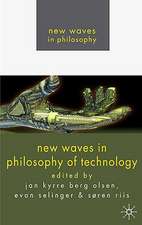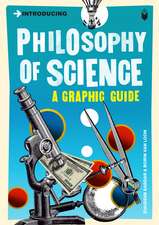Models of Scientific Development and the Case of Nuclear Magnetic Resonance: Synthese Library, cartea 184
Autor Henk Zandvoorten Limba Engleză Hardback – 30 sep 1986
| Toate formatele și edițiile | Preț | Express |
|---|---|---|
| Paperback (1) | 641.71 lei 6-8 săpt. | |
| SPRINGER NETHERLANDS – oct 2011 | 641.71 lei 6-8 săpt. | |
| Hardback (1) | 648.05 lei 6-8 săpt. | |
| SPRINGER NETHERLANDS – 30 sep 1986 | 648.05 lei 6-8 săpt. |
Din seria Synthese Library
- 15%
 Preț: 638.43 lei
Preț: 638.43 lei - 18%
 Preț: 989.98 lei
Preț: 989.98 lei - 15%
 Preț: 596.69 lei
Preț: 596.69 lei - 18%
 Preț: 903.93 lei
Preț: 903.93 lei - 15%
 Preț: 586.88 lei
Preț: 586.88 lei - 15%
 Preț: 696.50 lei
Preț: 696.50 lei - 18%
 Preț: 892.90 lei
Preț: 892.90 lei - 15%
 Preț: 643.34 lei
Preț: 643.34 lei -
 Preț: 282.33 lei
Preț: 282.33 lei - 5%
 Preț: 372.19 lei
Preț: 372.19 lei -
 Preț: 443.10 lei
Preț: 443.10 lei - 15%
 Preț: 637.59 lei
Preț: 637.59 lei - 18%
 Preț: 958.88 lei
Preț: 958.88 lei - 15%
 Preț: 642.36 lei
Preț: 642.36 lei - 18%
 Preț: 1230.66 lei
Preț: 1230.66 lei - 15%
 Preț: 642.83 lei
Preț: 642.83 lei - 18%
 Preț: 1000.39 lei
Preț: 1000.39 lei -
 Preț: 389.70 lei
Preț: 389.70 lei - 15%
 Preț: 637.28 lei
Preț: 637.28 lei - 18%
 Preț: 952.26 lei
Preț: 952.26 lei - 18%
 Preț: 1231.32 lei
Preț: 1231.32 lei - 15%
 Preț: 645.96 lei
Preț: 645.96 lei -
 Preț: 395.85 lei
Preț: 395.85 lei -
 Preț: 400.47 lei
Preț: 400.47 lei - 18%
 Preț: 1225.48 lei
Preț: 1225.48 lei - 15%
 Preț: 638.89 lei
Preț: 638.89 lei - 18%
 Preț: 1232.09 lei
Preț: 1232.09 lei -
 Preț: 380.45 lei
Preț: 380.45 lei -
 Preț: 394.87 lei
Preț: 394.87 lei - 15%
 Preț: 640.37 lei
Preț: 640.37 lei - 15%
 Preț: 639.08 lei
Preț: 639.08 lei -
 Preț: 381.98 lei
Preț: 381.98 lei - 15%
 Preț: 643.00 lei
Preț: 643.00 lei - 15%
 Preț: 672.29 lei
Preț: 672.29 lei
Preț: 648.05 lei
Preț vechi: 762.42 lei
-15% Nou
Puncte Express: 972
Preț estimativ în valută:
123.100€ • 129.48$ • 102.40£
123.100€ • 129.48$ • 102.40£
Carte tipărită la comandă
Livrare economică 15-29 aprilie
Preluare comenzi: 021 569.72.76
Specificații
ISBN-13: 9789027723512
ISBN-10: 9027723516
Pagini: 304
Ilustrații: 304 p.
Greutate: 0.63 kg
Ediția:1986
Editura: SPRINGER NETHERLANDS
Colecția Springer
Seria Synthese Library
Locul publicării:Dordrecht, Netherlands
ISBN-10: 9027723516
Pagini: 304
Ilustrații: 304 p.
Greutate: 0.63 kg
Ediția:1986
Editura: SPRINGER NETHERLANDS
Colecția Springer
Seria Synthese Library
Locul publicării:Dordrecht, Netherlands
Public țintă
ResearchCuprins
I. Research Programmes and Criteria for Cognitive Success: Some Views from Recent Philosophy of Science.- 1. Popper’s view on scientific progress.- 2. What counts as a proper prediction?.- 3. Lakatos’s view on scientific development: research programmes.- 4. Criteria for a successful research programme.- 5. Guide to the next chapters.- II. The Nuclear Magnetic Resonance Experiment: The Birth of a New Research Programme.- 1. The prehistory of the nmr experiment.- 2. The nmr experiment and its underlying theory.- 3. Global significance of the nmr experiment: the birth of a new research programme.- 4. Local significance of the first nmr experiments: disconfirming the prevailing theory of the nmr phenomenon.- 5. Gorter’s bad luck, or why he did not win a Nobel prize.- III. Lakatos’s Theory and the Nuclear Magnetic Resonance Programme; The Conceptual Adequacy of Lakatos’s Theory.- 1. The descriptive claims connected with Lakatos’s theory of scientific development.- 2. The nmr programme and the conceptual adequacy of Lakatos’s theory.- 3. A first modification of Lakatos’s theory.- IV. The Development of the Nuclear Magnetic Resonance Programme; The Explanatory Failure of Lakatos’s Theory.- 1. The BPP theory of nuclear magnetic relaxation; its Lakatosian merits; and some methodological problems encountered in establishing such merits.- 2. Line shapes in solids.- 3. Nmr phenomena in metals.- 4. The chemical shift.- 5. A shift in liquids due to paramagnetic ions.- 6. The hyper fine splitting.- 7. Remarks on later developments of the nmr programme.- 8. Conclusions.- V. Theories from the Nmr Programme as Theories of Measurement: Resolving the Anomaly.- 1. Nmr theories as theories of measurement.- 2. The phenomena being observed in applying theories of nmr belongto other domains.- 3. The dependence of the nmr programme on extrinsic success.- VI. The Structure of Theory Development: The Nmr Programme Seen from the Structuralist Perspective.- 1. The structuralist perspective on “normal science”.- 2. The theory net representing the nmr programme.- 3. The nature of the elaboration relation 190.- 4. Elucidation of the “conceptual” terms of Lakatos’s theory.- VII. Intrinsic Success and Extrinsic Success of Research Programmes; A Model of Scientific Development Unifying the Approaches of Lakatos and the Starnberg School.- 1. External influentiability according to the Starnberg school; two successive models.- 2. The limitations of Lakatos’s model and of the Starnberg finalization model.- 3. Intrinsic success and extrinsic success of research programmes.- 4. Links with the views of the physicists: Weisskopf, Casimir, Weinberg.- Notes.- Index of Names.














